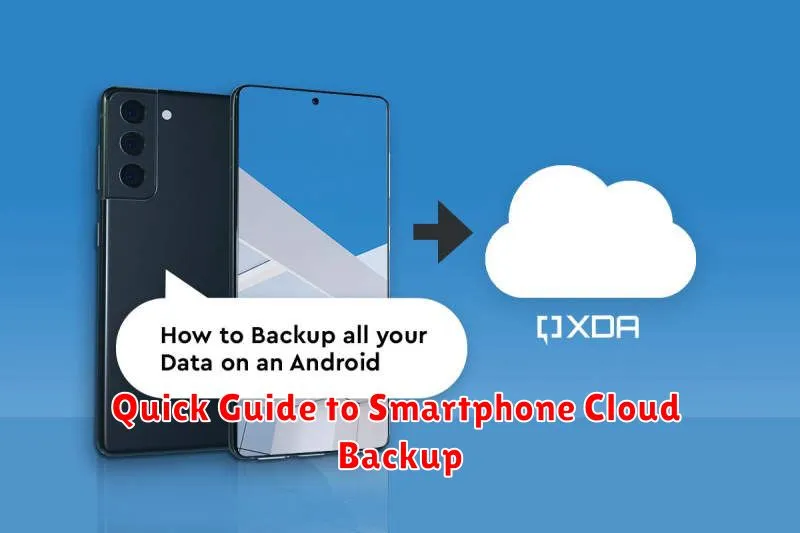In today’s digital age, our smartphones hold an immense amount of valuable data, from cherished photos and videos to important contacts and documents. Losing this data can be devastating. A smartphone cloud backup provides a safe and convenient solution to protect against data loss due to theft, damage, or accidental deletion. This quick guide will introduce you to the essentials of smartphone cloud backup, outlining its benefits and providing a clear understanding of how to implement it effectively. Learning how to back up your smartphone to the cloud is crucial for everyone who relies on their device for storing important information.
This guide will explain the benefits of cloud backup, compare different cloud backup services, and walk you through the process of setting up automatic backups. Whether you’re using an Android device or an iPhone, understanding smartphone cloud backup is a vital step in safeguarding your digital life. We’ll cover the key features to look for and offer practical tips for ensuring your data is secure and readily accessible when you need it most. By the end of this quick guide, you’ll be equipped to choose the best cloud backup solution for your smartphone and implement a robust backup strategy.
Benefits of Cloud Backup
Cloud backup offers several advantages for safeguarding your smartphone data.
Accessibility is a key benefit. Your backed-up data is accessible from any device with an internet connection, providing convenient retrieval if your phone is lost, stolen, or damaged. This also allows for seamless transitions between devices.
Automated backups simplify the process. You can schedule regular backups, ensuring your data is consistently protected without manual intervention. This eliminates the risk of forgetting to back up important information.
Cloud backup offers robust data security. Reputable cloud providers employ strong encryption and multiple data centers, protecting your data from unauthorized access and minimizing the risk of data loss due to hardware failure.
Cost-effectiveness is another advantage. Many cloud providers offer competitive pricing plans, including free tiers for limited storage, making cloud backup an affordable solution for protecting valuable data.
Setting Up Google Drive Backup

Google Drive offers a seamless backup solution for your smartphone, safeguarding your essential data. This process allows you to store a variety of data, including contacts, app data, photos, and videos.
To initiate the backup, navigate to the Settings app on your device. Locate and select the “System” section, then tap on “Backup.” Here, you’ll encounter the option to “Back up to Google Drive.” Ensure this option is toggled on. You can select the Google account you wish to use for the backup if you have multiple accounts configured on your device.
It is highly recommended to connect your device to a Wi-Fi network before starting the backup, especially if backing up a significant amount of data such as photos and videos. This will prevent excessive data usage on your mobile plan.
iCloud Backup Essentials
iCloud offers a seamless backup solution for Apple devices. It automatically backs up your data when your device is connected to Wi-Fi, locked, and plugged in to power. This ensures your information is readily available if your device is ever lost, stolen, or damaged.
Key features of iCloud Backup include safeguarding your photos and videos, app data, device settings, message history, ringtones, and visual voicemail. This comprehensive approach minimizes data loss and simplifies the setup process on a new device.
Managing your iCloud storage is crucial. Apple provides a free 5GB of storage. However, this may be insufficient for most users. Upgrading to a larger storage plan is often necessary to accommodate all essential data. You can manage your storage and choose a plan that aligns with your needs directly within your device’s settings.
Restoring from an iCloud backup is straightforward. During the initial setup of a new device, or after erasing an existing one, choose the option to restore from an iCloud backup. Select your most recent backup, and your data will be downloaded and restored to your device.
Managing Storage Limits
Cloud backup services often offer a limited amount of free storage. Understanding these limits and employing strategies to manage them is crucial for successful backups.
Check Your Storage Plan: Most providers clearly display your current usage and storage limit. This information is usually accessible through the app settings or website.
Optimize Backup Content: Be selective about what you back up. Do you need to back up every photo and video? Consider backing up only essential data, such as contacts, messages, and important documents.
Delete Unnecessary Backups: Older backups or backups of devices you no longer use can consume valuable space. Regularly review your backups and delete any that are no longer needed.
Upgrade Your Storage Plan: If your free storage is consistently full, consider upgrading to a paid plan. Paid plans usually offer significantly more storage and additional features.
Restoring Data from Cloud
Restoring your data from a cloud backup is generally a straightforward process. The specific steps may vary slightly depending on your device’s operating system (e.g., Android or iOS) and the cloud service provider (e.g., Google Drive, iCloud). However, the general principle remains the same.
Typically, you’ll need to sign in to your cloud account on your smartphone. After successful authentication, you should be presented with an option to restore your data. This might involve selecting a specific backup or choosing which data categories to restore, such as contacts, photos, or apps.
Ensure your device is connected to a stable Wi-Fi network during the restoration process, as restoring large amounts of data can consume significant mobile data. The duration of the restoration will depend on the amount of data being restored and the speed of your internet connection.
Once the restoration is complete, your device will restart, and your data should be available. It’s always a good practice to verify that all your important data has been successfully restored.

